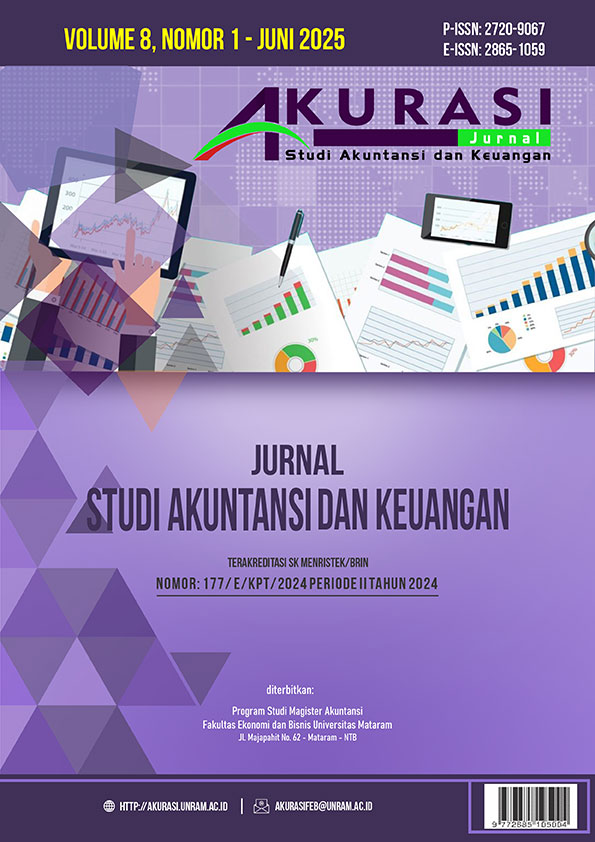EXPLORING THE ROLE OF KEY AUDIT MATTERS DISCLOSURE IN MITIGATING INVESTMENT RISK
DOI:
https://doi.org/10.29303/akurasi.v8i1.703Keywords:
ISA701, key audit matter, investment risk, idx, audit reportAbstract
This study examines the impact of Key Audit Matters (KAM) disclosures on investment risk in the context of Indonesia’s evolving audit transparency landscape. The research is motivated by the implementation of SA701, which requires KAM disclosures in audit reports. The purpose of this study is to investigate how different aspects of KAM disclosures influence investor perceptions of risk. Using a quantitative approach, we analyze data from more than 700,000 stock data points and 1,358 firm-year observations of companies listed on the Indonesia Stock Exchange (IDX) from 2022 to 2023. Regression analysis reveals that detailed KAM disclosures (KAM2) significantly reduce investment risk, while the number of KAM disclosed (KAM1) and monetary information (KAM3) show no significant effect. These findings highlight the importance of contextual and thorough audit disclosures in reducing information asymmetry. The study contributes to the literature by emphasizing the role of audit transparency in emerging markets and provides practical recommendations for regulators to enhance KAM reporting standards.
Downloads
References
Abdullatif, M., Alzebdieh, R., & Ballour, S. (2023). The effect of key audit matters on the audit report lag: evidence from Jordan. Journal of Financial Reporting and Accounting, 23(1), 257–284. https://doi.org/10.1108/jfra-07-2022-0245
Adil, M., Singh, Y., & Ansari, M. S. (2021). How financial literacy moderate the association between behaviour biases and investment decision? Asian Journal of Accounting Research, 7(1), 17–30. https://doi.org/10.1108/ajar-09-2020-0086
Akerlof, G. A. (1970). The market for “lemons”: Quality uncertainty and the market mechanism. The Quarterly Journal of Economics, 84(3), 488–500. https://doi.org/10.2307/1879431
Al-Hadrami, A. H., Rafiki, A., Sarea, A., & Muhammad Dharma Tuah Putra Nasution. (2020). Is the investment decision affected by the independence and competence of the audit committee? a comparative study between Bahrain and Indonesia. Journal of Investment Compliance, 21(1), 29–48. https://doi.org/10.1108/joic-05-2020-0005
Al‐mulla, M., & Bradbury, M. E. (2021). Auditor, client, and investor consequences of the enhanced auditor’s report. International Journal of Auditing, 26(2), 134–150. https://doi.org/10.1111/ijau.12255
Alverina, G. C. A., & Hadiprajitno, P. T. B. (2022). Pengaruh profitabilitas, financial distress, ukuran perusahaan, reputasi auditor dan opini audit terhadap audit report lag. Diponegoro Journal Of Accounting 11(1), 1-13.
Asbahr, K., & Ruhnke, K. (2019). Real effects of reporting key audit matters on auditors’ judgment and choice of action. International Journal of Auditing, 23(2), 165–180. https://doi.org/10.1111/ijau.12154
Baatwah, S. R., Almoataz, E. S., Omer, W. K. H., & Aljaaidi, K. S. (2022). Does KAM disclosure make a difference in emerging markets? An investigation into audit fees and report lag. International Journal of Emerging Markets, 19(3), 798–821. https://doi.org/10.1108/ijoem-10-2021-1606
Brouwer, A., Eimers, P., & Langendijk, H. P. (2016). The relationship between key audit matters in the new auditor’s report and the risks reported in the management report and the estimates and judgments in the notes to the financial statements. Maandblad Voor Accountancy En Bedrijfseconomie, 90(12), 580–613. https://doi.org/10.5117/mab.90.31228
Genç, E. G., & Erdem, B. (2021). The analysis of the relationship between key audit matters (KAM) and firm characteristics: the case of Turkey. Emaj Emerging Markets Journal, 11(1), 60–66. https://doi.org/10.5195/emaj.2021.219
Gold, A., & Heilmann, M. (2019). The consequences of disclosing key audit matters (KAM): a review of the academic literature. Maandblad Voor Accountancy En Bedrijfseconomie, 93(1/2), 5–14. https://doi.org/10.5117/mab.93.29496
Jogiyanto. (2017). Teori portofolio dan analisis investasi (11th ed.). BPFE: Yogyakarta.
Kend, M., & Nguyen, L. A. (2022). Key audit risks and audit procedures during the initial year of the COVID-19 pandemic: an analysis of audit reports 2019-2020. Managerial Auditing Journal, 37(7), 798–818. https://doi.org/10.1108/maj-07-2021-3225
Khakhanaev, U. S.-E. (2019). The study into factors reducing investment project financing risks. Digest Finance, 24(4), 395–402. https://doi.org/10.24891/df.24.4.395
Li, X. (2015). Research on financial risk management based on var model. The Open Cybernetics & Systemics Journal, 9(1), 1849–1852. https://doi.org/10.2174/1874110x01509011849
Longyuan, S., Zhang, Y., & Chun-yu, X. (2022). Research on influencing factors of key audit matters disclosure in China. International Journal of Innovative Research and Development. https://doi.org/10.24940/ijird/2022/v11/i9/sep22010
Maani, A. A., Buraik, O., Al-Amarneh, A., & Almashaqbeh, M. (2024). The effect of the audit committee on the voluntary risk disclosure in Jordanian commercial banks: the moderating role of family ownership. https://doi.org/10.20944/preprints202408.0667.v1
Mathew, S. K. (2011). Mitigation of risks due to service provider behavior in offshore software development. Strategic Outsourcing an International Journal, 4(2), 179–200. https://doi.org/10.1108/17538291111148008
Matta, J., & Feghali, K. (2021). The impact of Key Audit Matters (KAM) on financial information quality: Evidence from Lebanon. Indonesian Management and Accounting Research, 19(2), 135–162. https://doi.org/10.25105/imar.v19i2.7328
Mukhibad, H., Nurkhin, A., & Rohman, A. (2020). Corporate governance mechanism and risk disclosure by Islamic banks in Indonesia. Banks and Bank Systems, 15(1), 1–10. https://doi.org/10.21511/bbs.15(1).2020.01
Nguyen, L. A., & Kend, M. (2021). The perceived impact of the KAM reforms on audit reports, audit quality, and auditor work practices: stakeholders’ perspectives. Managerial Auditing Journal, 36(3), 437–462. https://doi.org/10.1108/maj-10-2019-2445
Pfeiferová, D., & Kuchařová, I. (2020). Risks of collective investment undertakings in the context of global capital markets. SHS Web of Conferences, 74, 01025. https://doi.org/10.1051/shsconf/20207401025
Putri, D. T., & Nursiam, N. (2021). Ukuran kantor akuntan publik (KAP), opini auditor, financial distress, dan pergantian manajer pada auditor switching. Perspektif Akuntansi, 4(3), 277–296. https://doi.org/10.24246/persi.v4i3.p277-296
Ren, D., & Du, J. (2020). Analysis on behavior characteristics of enterprise financing investment risk data. 315–325. https://doi.org/10.1007/978-3-030-51100-5_28
Sania, W., & Ali, S. (2024). The impact of audit fee, size of public accounting firm, company size, and leverage on the communication of key audit matters (implementation of the first year of KAM adoption in independent auditors’ reports in Indonesia). Eduvest - Journal of Universal Studies, 4(10), 9547–9564. https://doi.org/10.59188/eduvest.v4i10.38822
Segal, M. (2019). Key audit matters: insight from audit experts. Meditari Accountancy Research, 27(3), 472–494. https://doi.org/10.1108/medar-06-2018-0355
Sen, P. K. (2020). Accuracy of disclosure environment and subsidies for foreign investments. Journal of Accounting Auditing & Finance, 38(1), 29–51. https://doi.org/10.1177/0148558x20962900
Septyadi, M. A., & Bwarleling, T. H. (2020). Pengaruh volume perdagangan saham, leverage, dan kebijakan dividen terhadap volatilitas harga saham. AKURASI: Jurnal Riset Akuntansi dan Keuangan, 2(3), 149–162. https://doi.org/10.36407/akurasi.v2i3.251
Setyawan, I. R. (2010). Stock split dan likuiditas saham di bei: pengujian menggunakan hipotesis likuiditas. Jurnal Akuntansi dan Keuangan Indonesia, 7(2), 124–138. https://doi.org/10.21002/jaki.2010.07
Shao, X. (2020). Research on disclosure status and influencing factors of key audit matters. Modern Economy, 11(03), 701–725. https://doi.org/10.4236/me.2020.113052
Siagian, V. (2023). Auditor’s reputation and auditor’s opinion on stock prices: Evidence from Indonesia’s main board index. The Indonesian Accounting Review, 13(2), 221–232. https://doi.org/10.14414/tiar.v13i2.3345
Sirois, L.-P., Bédard, J., & Bera, P. (2018). The informational value of key audit matters in the auditor’s report: evidence from an eye-tracking study. Accounting Horizons, 32(2), 141–162. https://doi.org/10.2308/acch-52047
Spence, M. (1973). Job market signaling. The Quarterly Journal of Economics, 87(3), 355–374. JSTOR. https://doi.org/10.2307/1882010
Syahyono, S. (2018). Effect of portfolio investment optimization risk-based and efficiency investment on investment decision. Fair Value Jurnal Ilmiah Akuntansi Dan Keuangan, 1(1), 124–131. https://doi.org/10.32670/fairvalue.v1i1.1193
Wooldridge, J. (2013). Introductory Econometrics: A Modern Approach. Cengage Learning.
Wulandari, S. (2021). Investment risk management for vanilla agribusiness development in Indonesia. E3s Web of Conferences, 232, 02022. https://doi.org/10.1051/e3sconf/202123202022
Yue, Y. (2022). Empirical study on the impact of key audit disclosure on stock price in audit reports. BCP Business & Management, 20, 519–524. https://doi.org/10.54691/bcpbm.v20i.1026
Yulianto, A. R. (2025). Key audit matter and audit report lag: A preliminary evidence from Indonesia. Journal of Emerging Economies and Islamic Research. https://doi.org/10.24191/jeeir.v13i1.4432
Zhang, L. (2020). A study of the impact of information disclosure quality on the efficiency of corporate investment—based on civil engineering listed companies. E3s Web of Conferences, 198, 03032. https://doi.org/10.1051/e3sconf/202019803032
Downloads
Published
How to Cite
Issue
Section
License
Authors who publish in Akurasi: Jurnal Studi Akuntansi dan Keuangan agree to the following terms:
- Authors retain the copyright of their articles.
- Authors grant Akurasi: Jurnal Studi Akuntansi dan Keuangan the right of first publication.
- Articles are licensed under the Creative Commons Attribution-ShareAlike 4.0 International License (CC BY-SA 4.0).
- This license allows anyone to copy, distribute, display, and adapt the articles for any purpose, including commercial use, as long as proper credit is given to the author(s) and the source, and derivative works are distributed under the same license.
- All published articles are open access and may be used for educational, research, and scientific purposes.
License: 
This work is licensed under a Creative Commons Attribution-ShareAlike 4.0 International License.







